Since its shift to the reform and opening-up policy at the end of the 1970s, China has achieved development based on processing trade heavily dependent on foreign countries both as sources of technologies and parts and as markets by exploiting advantages such as its abundant labor and low wages. However, in recent years, the limitations of China's development strategy that depends on the "international circulation" centered around processing trade have become apparent not only because the labor supply has turned from a surplus to a shortage but also because protectionism has risen abroad and the United States has implemented a "decoupling" policy that seeks to sever the link between the U.S. and Chinese economies. In response, the Chinese government has launched a "dual circulation" strategy, under which domestic and international circulations would mutually promote each other, with the domestic circulation as the main element." At the Fifth Plenary Session of the 19th Communist Party of China Central Committee held on October 26-29, 2020 to deliberate the 14th Five-Year Plan (2021-2025) and long-term goals for the period until 2035, the dual circulation strategy formed the core theme of the discussion.
What is the dual circulation strategy?
The "dual circulation" concept was first presented on May 14, 2020, at the Standing Committee of the Political Bureau of the Central Committee of the Communist Party of China. The specifics of the strategy gradually became clear at a subsequent series of important meetings. The strategy can be summarized as follows based on speeches made by President Xi Jinping at a symposium with entrepreneurs on July 21 and at a symposium on economic and social work on August 24.
The dual circulation concept constitutes a new development strategy under which domestic and international circulations would mutually promote each other with the domestic circulation as the main element. It has been proposed to adapt to changes in China's development stage and environment, and is a strategic choice intended to promote China's international cooperation and create new competitive advantages for the country. In the past, when globalization was advancing, turning to the outside world as markets and as sources of resources played an important role in China's rapid development. However, under the current external environment of rising protectionism, a stagnant global economy, and a shrunken global market, China must fully exploit its huge domestic market as an advantage.
When executing the dual circulation strategy, China must maintain the policy of carrying out supply-side structural reforms and expanding domestic demand with the aim of achieving a virtuous cycle between supply and demand while placing emphasis on production, distribution, circulation and consumption. Moreover, China must develop new advantages necessary for its future development by upgrading supply chains, actively promoting technological innovation, and devoting efforts to the development of core technologies.
Of course, treating the domestic circulation as the main element is in no way the same as closing the door to the outside world and executing an isolationist policy. Rather, this approach seeks to realize more robust sustainable development by unlocking the potentials of domestic demand in order to successfully link the domestic and international markets and make the most of these two markets and domestic and foreign resources.
In sum, the essence of the dual circulation strategy is to reduce the dependence on the international circulation centered around trade and strengthen the domestic circulation that is comprised of the processes of production, distribution, circulation and consumption in terms of both supply and demand, while maintaining the policy of opening up to the outside world. Expanding consumption-led domestic demand and carrying out supply-side reforms intended to improve productivity and promote industrial upgrading through innovation are the main pillars of the strategy.
Background to the launch of the dual circulation strategy
One factor behind the launch of the dual circulation strategy is that the limitations of the previous international circulation centered around processing trade have become apparent as a result of changes in the internal and external environments, while China's advantages as being a big country that support the domestic circulation have become prominent.
1) Limitations of the international circulation centered around processing trade that have become apparent
In China, processing trade has been at the center of the international circulation since its shift to the reform and opening-up policy. Exporting companies are heavily dependent on foreign countries as sources of technologies and funds and have adopted the business model of importing intermediate goods, such as raw materials and parts, on a massive scale and exporting finished products processed and assembled in China.
According to the "smiling curve" analysis of value added in supply chain processes, China's areas of competitive strength were limited to the "lower jaw" part of the smiling curve, which corresponds to labor-intensive processes, such as processing and assembly (Figure 1). Whereas value added is high in the upstream (research and development, and production of key parts) and downstream (sales and after-sales services) of the supply chain, where developed countries are superior, it is low in the midstream (assembly), where China is strong.
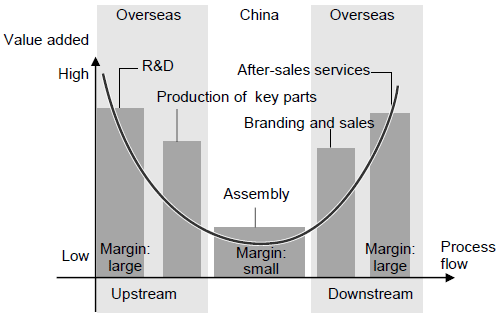
Initially, processing trade prospered in China because of low labor cost, bringing generous profits to exporting companies. As the market share of Chinese products abroad expanded, China established its position as the "world's factory." However, in recent years, the situation of processing trade has become difficult against the backdrop of changes in internal and external environments.
First, in China, the labor supply has turned from a surplus to a shortage and wages have risen due to the aging of society coupled with a declining birthrate and the depletion of excess labor in rural areas. As a result, China's international competitiveness has declined with respect to labor-intensive processes, such as assembly.
In addition, amid the intensifying U.S.-China trade friction, some companies are shifting production from China to other countries in order to evade sanctions and additional tariffs imposed by the United States.
Moreover, because of the COVID-19 pandemic, China is facing pressures on both the supply and demand sides. While foreign markets are stagnant, some parts are in short supply.
Against the background of those factors, China's dependence on trade (the ratio of exports and imports to GDP) declined to 31.8% in 2019 after peaking at 64.2% in 2006 (Figure 2). In both imports and exports, the share of processing trade declined (Figure 3). In particular, the decline in the share of processing trade is more conspicuous in imports than in exports, and reflecting this trend, the share of value added created by processing trade is rising.
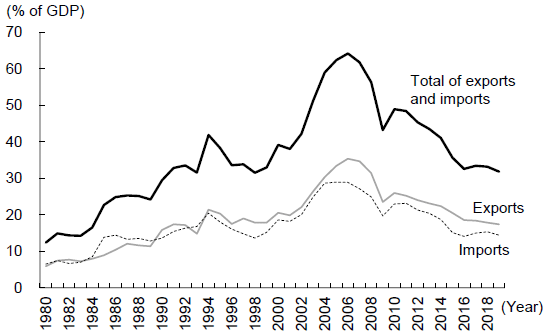
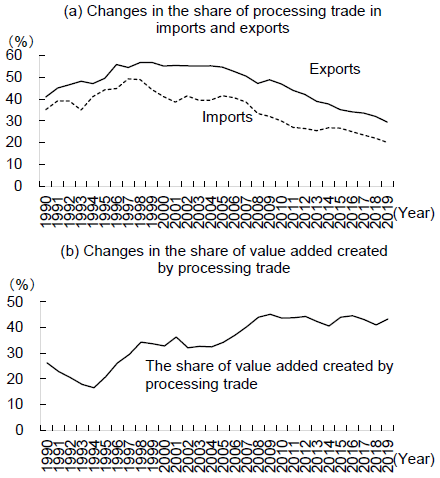
2) China's prominent advantage as an economic power
On the other hand, China's population, 1.4 billion people, is the largest in the world, and its GDP is equivalent to 67.0% of the U.S. economy and is the second largest in the world (both figures are as of 2019), providing favorable conditions for promoting the domestic circulation.
First, as Adam Smith, who is considered to be the father of modern economics, pointed out in The Wealth of Nations, "the division of labor is limited by the extent of the market." A huge domestic market enables production on a massive scale and expansion of the scale of production leads to the deepening of the division of labor and promotes the specialization of production, further improving labor productivity and production efficiency. As China has taken advantage of the virtuous cycle of market expansion and industrialization and ridden the wave of globalization, the Chinese manufacturing industry overtook its U.S. counterpart in terms of the size of value added created, becoming the world's largest in 2010.
Next, the huge size of the domestic market is favorable for the growth of large companies, which can strengthen their competitiveness through cost reduction and efficiency improvement by making more effective use of economies of scale and scope. The number of Chinese companies listed in "Fortune Global 500," announced by Fortune magazine of the United States, has been increasing year after year, and in 2020, the number came to 120 companies (excluding companies in Hong Kong and Taiwan), placing China just below the United States, which boasted the largest number of companies listed in the rankings, 121. What is noteworthy is that while most of the Chinese companies in the Fortune Global 500 list are still state-owned enterprises, the number of private enterprises increased to 28 in 2020, up from zero in 2007 (Figure 4).
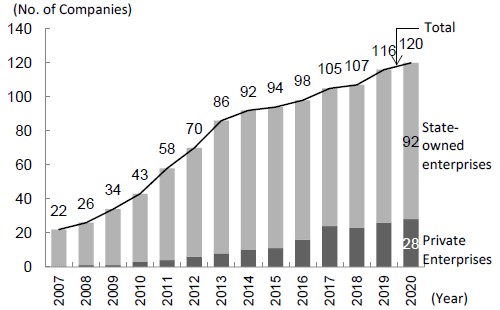
The huge size of China's domestic market is also favorable for innovation, which holds the key to productivity improvement. Since innovation requires massive research and development (R&D) investments and involves high risks, sufficient profits for this purpose cannot be expected to be earned in a small market. In addition, the supply of human resources for R&D activity in China is also expanding rapidly, thanks to the diffusion of higher education, particularly in science and engineering. By exploiting these advantages, China has been enhancing its innovation capability. According to the Global Innovation Index 2020, which was announced jointly by Cornell University of the United States, INSEAD of France and the World Intellectual Property Organization (WIPO), and which ranked the innovation capability and performance of national economies, China was ranked 14th, higher than Japan (16th), among the 131 countries and economies covered by the survey (Figure 5). In the global rankings of science and technology clusters in the same survey, there were three Chinese clusters in the top 10: the Shenzhen-Hong Kong-Guangzhou area in second place, Beijing in fourth place, and Shanghai in ninth place. In terms of the number of articles adopted by major science journals, as counted by the journal Nature (Nature Index), China was the global No. 2, after the United States, in 2019, with the gap between the two countries narrowing year after year.
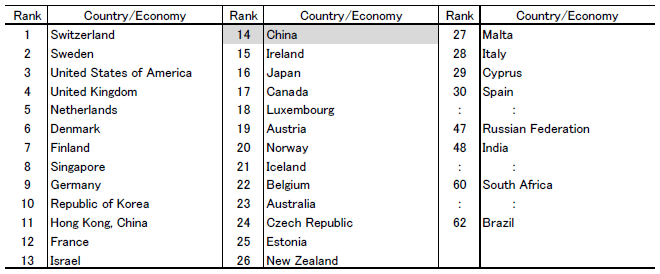
Measures to promote the dual circulation
To promote the domestic circulation, which is the main element under the dual circulation strategy, the urgent task is to carry out supply-side reforms at the same time as expanding consumption-led domestic demand.
With respect to the expansion of domestic demand, in response to the Lehman Shock in 2008, China implemented an economic stimulus package worth 4 trillion yuan centered on investments in infrastructure, including railways, roads, airports, ports and water management facilities. However, under the Chinese government's current plan to promote the domestic circulation, consumption will play the leading role in expanding domestic demand. Although the ratio of private consumption to GDP in China has trended upward after bottoming out at 34.6% in 2010, it was still only 38.8% in 2019. This was the lowest level among the world's major countries, which means that there is ample room for improvement through policy reform.
The greatest cause of sluggish consumption in China is the wide income inequality between urban and rural areas. Indeed, in China, the ratio of private consumption to GDP has tended to move in synchronization with the ratio of rural-area income to urban-area income per capita over the long term (Figure 6). Moreover, the underdevelopment of social security systems and the heavy burden of debt repayment on households due to rising housing prices are also considered to be factors holding down consumption. To expand consumption, this situation must be corrected.
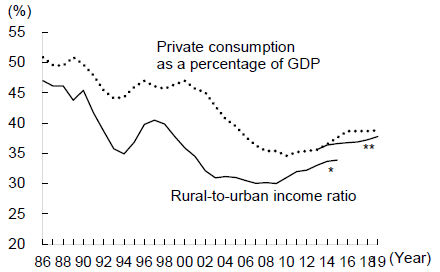
**.Per-capital disposable income in both urban and rural areas.
As for supply-side reforms, the Chinese government has indicated the following policy.
First, market reforms must be accelerated. Specifically, China must tap into corporate vitality through the following measures: optimization of resource allocation and structural reforms of the state-owned economy (inputting more state-owned capital into areas important for the people's lives and areas critical for the national economy, including science and technology, defense and security); promotion of the reform of the mixed ownership system that injects private capital into state-owned enterprises; promotion of the reform of natural monopoly industries; and improvement of institutional systems to support the development of the non-state-owned economy, including private enterprises. In addition, China must ensure fair market competition through the following measures: enhancing the private economy and strengthening the protection of various property rights, including farmland; fully implementing the negative list system regarding market entry, and strengthening and improving the enforcement of anti-monopoly and anti-unfair competition laws (Note 1).
Moreover, China must devote efforts to improving productivity through innovation. Specifically, China must develop its own core technologies, accelerate the conversion of science and technology achievements into production capacity, and strengthen supply chains. China must also enable companies to exercise their technology innovation capability and develop an innovation system under which the fields of science and technology, education, industry, and finance are deeply integrated. Furthermore, China must foster first-class researchers and research teams and strengthen international exchange and cooperation in science and technology (Note 2).
While placing emphasis on the domestic circulation, China is trying to maintain the vitality of the international circulation by continuing to actively promote the opening-up policy. At the symposium on economic and social work held on August 24, President Xi Jinping made the following remarks in order to emphasize the need to promote international cooperation and develop new competitive advantages by achieving a high level of opening-up to the outside world with the following statement:
"At present, the international community has many worries about the prospect of economic globalization. We believe that international economic connectivity and exchanges are still the objective requirements of world economic development. An important driving force for China's sustained and rapid economic development is opening up. Opening to the outside world is a basic national policy. We must comprehensively raise the level of opening up, build a new higher-level open economic system, and form new advantages in international cooperation and competition. It is necessary to actively participate in the reform of the global economic governance system and promote the improvement of a fairer and more reasonable international economic governance system."
Adjustments between international to domestic circulations
In addition to promoting each of the international and domestic circulations, another pillar of the dual circulation strategy is to make adjustments between international and domestic circulations mainly by reducing the high dependence on processing trade. Regarding supply chains, adjustments can be made mainly by shifting procurement sources of parts and other intermediate goods in the upstream from foreign to domestic suppliers and product sales targets in the downstream from foreign to domestic customers.
As production processes are closely connected with each other through the supply chain, even the disruption of supply of some parts causes the entire production to shut down. As has been highlighted by the supply disruptions caused by the effects of the COVID-19 pandemic and the imposition of export restrictions by the United States against some Chinese companies, in order to strengthen supply chains, it is necessary to reduce dependence on imports for the supply of critical parts and raise the self-sufficient rate so that domestic procurement can be ensured.
In China, one weak point of the supply chain is the semiconductor sector. The value of integrated circuits produced in China in 2019 was 19.5 billion dollars, or only 15.7% of the value of the integrated circuit market in the country, which was 125.0 billion dollars. Of the production value in China, only 7.6 billion dollars' worth was produced by companies headquartered in China, with the rest manufactured by foreign companies, including Taiwan Semiconductor Manufacturing Company (TSMC), SK Hynix, Samsung, and Intel (Note 3). In the ongoing U.S.-China high-tech war, the United States is using the imposition of limits on the supply of semiconductors to Huawei and other Chinese companies as an effective weapon. For China, expanding domestic semiconductor production capacity is the top industrial policy priority.
In order to realize domestic production of critical parts, it is essential to cooperate with foreign countries in introducing technologies and facilities in addition to making the most of domestic resources. Not only Chinese companies but also many multinational companies are strengthening production systems in China, including by developing supply chains, in order to increase local sales.
On the other hand, shifting product sales targets to domestic customers can satisfy the needs of both producers and consumers. Chinese exporting companies, which are facing the rising tide of protectionism and the prolonged stagnation of the global economy, can find a way out of the situation by obtaining new customers through the shift. In recent years, rapidly growing internet sales have provided Chinese exporting companies with a convenient sales route. Meanwhile, domestic consumers will be given a wider range of options, including the purchase of better products. As a result of intensified competition between companies, product prices will fall and quality will improve, bringing benefits to consumers. In this way, shifting product sales targets from foreign to domestic customers leads to not only expansion of consumption but also sophistication of the consumption structure.
Those adjustments regarding supply chain processes are expected to affect the global economy, too. The replacement of imports of parts and other intermediate goods in the upstream by domestic production in China is likely to curb China-bound exports from developed countries and regions, such as Japan, South Korea and Taiwan. On the other hand, the replacement of exports of final products in the downstream with domestic sales is likely to provide opportunities for emerging industrial countries, including ASEAN countries, to increase their global market shares regarding labor-intensive products.
Mutual promotion of domestic and international circulations
As China implements the dual circulation strategy, domestic and international circulations are expected to mutually promote each other. If the domestic circulation is strengthened, consumption-led domestic demand will expand and industries will become more sophisticated. As a result, the Chinese market will become more attractive, and more foreign companies will seek to expand business in the Chinese market through exports, or local production and sales. On the other hand, strengthening the international circulation by promoting opening-up to the world will lead to strengthening of the domestic circulation as well. In particular, the introduction of foreign technologies through inward and outward foreign direct investments will remain the key to industrial upgrading. Now that it has become difficult to introduce technologies from the United States, cooperation with other developed countries, such as Japan and European countries, will become more and more important.
The original text in Japanese was posted on October 14, 2020.


